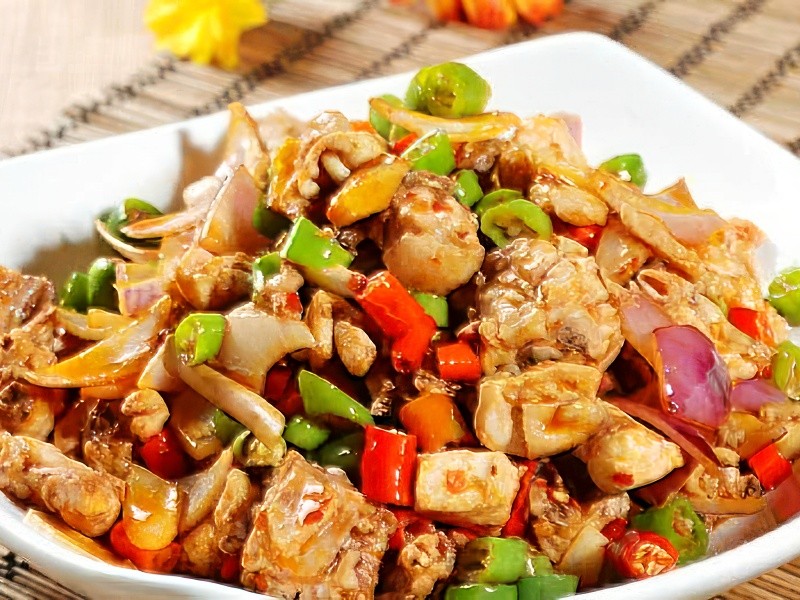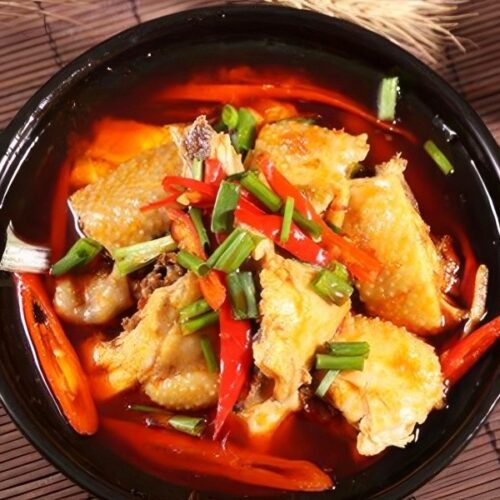Dongan chicken is one of the most famous Hunan dishes. It is a delicious mixture of chicken flavored with chili peppers and spices with clear rice vinegar. This is a classic Hunan chicken dish that is delicious and simple to prepare. Pre-cooked chicken is cut into pieces, then sautéed with chili, ginger, Szechuan pepper and vinegar. This dish was selected for the list of four traditional dishes of Hunan Province at the 2010 World Expo in Shanghai .
According to traditional Chinese medicine, both chili peppers and vinegar heat the body and are thus associated with “yang”. They balance the excess of “yin” caused by cold or humidity. Therefore, many dishes from the Hunan province are highlighted for their medicinal properties.

The origin of the Dongan chicken
Dongan chicken is said to have originated from a dish known as vinegar chicken (Cu Jī 醋鸡), which dates back to the Tang Dynasty (618-907). The legend tells the story of traders who traveled from north to south and passed through the Dongan region, known for its rich markets. At night, hungry and tired, they stopped at a modest local inn run by three old ladies to ask for something to eat. Having used up almost all the ingredients in their pantry that day, the women had to improvise. They quickly killed a couple of chickens and cooked them for dinner. The dish was so delicious that traders spread the word about it on their travels. Thus began the story of the Dongan Chicken, which, thanks to merchants, reached faraway Chang’an .

Development of the Dongan chicken
Over the centuries, Dongan chicken has undergone fascinating evolutions, changes in recipe and names. During the Tang Dynasty, it was called “vinegar chicken” (醋鸡) due to the use of rice vinegar as the main ingredient. In the late Qin Dynasty, it became “guanbao chicken” (官保鸡) thanks to a frying technique called “guanbao”(hua chao). That’s when chili peppers were added to the recipe, which gave the dish not only spiciness, but also a distinctive color.
In the era of the Republic of China, the Dongan Chicken became inextricably associated with the general Tang Shen-che (唐生智). He was one of the leaders of the Northern March (北伐) in 1926. His personal chef cooked this dish to celebrate the victory of the expedition. Since then, Dongan Chicken has become an integral part of important events, including the banquet between Mao Zedong (毛泽东) and US President Nixon in 1972. Although the name and ingredients have changed throughout history, the touch of tradition and regional love for this dish remains unchanged . Dongan chicken is not only a delicious food, but also a living testimony of rich history and culture.
Preparation
The dish is prepared by first pre-cooking the chicken with ginger and green onions. It is then allowed to cool and cut into bite-sized pieces. Fresh chillies, dried chillies, ginger and green onions are then sliced and fried in peanut oil until they begin to smoke.
Finally, the chicken is added to the pan and stir-fried with a little Shaoxing rice wine and vinegar. Some recipes also add chicken stock to the mix to keep the chicken tender and juicy. The result is a mildly spicy dish with a pleasant sour taste.

Donganské kuře (Dong’an Zi Ji 東安子雞)
Ingredients
- 2 litry vývaru nebo vody na pošírování
- 2 ks kuřecích stehen (nebo celé kuře) 450 – 500g
- 1 3/4 palce čerstvého zázvoru neloupaný
- 3 ks jarní cibulky
- 1 ks čerstvé červené chilli
- 3 ks sušené červené chilli papričky
- 2 lžíce rýžového vína Shaoxing
- 2 lžíce čirého rýžového octa
- ½ lžíce celého sečuánského pepře
- 1 špetka soli podle chuti
- ¾ lžíce kukuřičného škrobu
- 1 lžička lžička sezamového oleje
- 4 lžíce oleje
Instructions
- Vývar přiveďte k varu ve velkém hrnci na vysokém plameni. Přidejte kuře a znovu přiveďte k varu. Rozdrťte polovinu zázvoru, jednu jarní cibulku a přidejte do hrnce s kuřetem. Snižte teplotu a vařte kuře 10 minut. Vyjměte kuře z hrnce a nechte jej vychladnout. Kuře by mělo být asi ze tří čtvrtin propečené.
- Když je kuře dostatečně vychladlé, nakrájejte jej na kousky velikosti sousta. Kůži nikdy nevyhazujte (kosti a odřezky masa lze vrátit do hrnce a uvařit si vývar do zásoby).
- Čerstvé chilli papričky rozkrojte podélně napůl, odstraňte semínka a nakrájejte na velmi jemné plátky. Zbylý zázvor oloupejte a nakrájejte na plátky. Na stejné plátky nakrájejte i sušené chilli papričky. Zelené části zbývajících 2 jarních cibulek nakrájejte na plátky podobné délky a dejte stranou.
- Zahřejte wok na vysokém plameni, dokud z něj nebude stoupat kouř, poté přidejte sádlo nebo olej. Když se olej rozehřeje, ale ještě předtím, než olej začne kouřit, přidejte čerstvé chilli papričky, zázvor, spolu se sušenými chilli a sečuánským pepřem. Za stálého míchání smažte, dokud se nerozvoní. Dávejte pozor, aby se koření nepřipálilo.
- Přidejte kousky kuřete a pokračujte v restování. Přidejte rýžové víno Shaoxing, ocet a sůl podle chuti. Přidejte až 1/2 šálku vody nebo vývaru, přiveďte k varu a poté trochu stáhněte plamen a krátce povařte, aby chutě pronikly do kuřete.
- Přidejte kukuřičný škrob a míchejte, dokud omáčka nezhoustne. Vhoďte nakrájenou jarní cibulku a několikrát promíchejte. Sundejte z plotny a vmíchejte sezamový olej. Podávejte.






